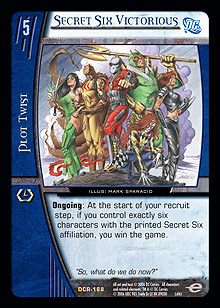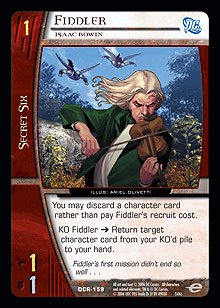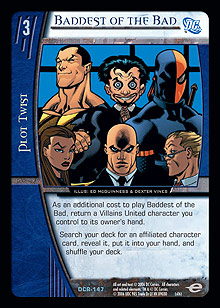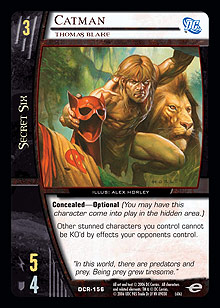
We’re on the verge of another Pro Circuit, and this one brings the Vs. System back to Indianapolis. In a little over a week, Vs. System players from around the world will head to Gen Con Indy to compete for the title of Pro Circuit Champion and an Extended Art Savage Beatdown. I suppose the $40,000 payday for first place doesn’t hurt, either!
This Pro Circuit’s Constructed format will be DC Modern Age and will use the Justice League of America and Infinite Crisis sets. I’m particularly excited about this PC, as it promises to be one of the most diverse Modern Age formats ever. This Modern Age boasts two of the strongest Vs. System sets released to date, and as a result, we have decks that span the breadth of archetypes. There are powerful representatives from each of the combat-based archetypes: curve (Secret Society and Checkmate), off-curve (Injustice Gang Army and JSA), and short-curve (Villains United and Good Guys). Disruption and control decks also hold potential with Shadowpact and the Injustice Gang hand flood strategy. Of course, there’s the proverbial “800-pound gorilla” in the Fate Artifacts. And the potential for alternate victories exists, thanks to Captain Marvel, Champion of Magic and Secret Six Victorious.
“I love the smell of Vs. System in the morning. It smells like . . . VICTORY!”
 When I was considering what deck to write about for DC Modern Age, I decided that I wanted to look at one of the less notable archetypes. Unfortunately, this wasn’t a simple proposition, as pretty much every archetype that I’ve mentioned is viable. Ultimately, it came down to personal preference. I decided to take a cue from my team and look at the alternate win conditions. Captain Marvel has already been thoroughly explored and abused in Silver Age with teched G’Lock decks, so that left me with one of my pet projects, Secret Six Victorious.
When I was considering what deck to write about for DC Modern Age, I decided that I wanted to look at one of the less notable archetypes. Unfortunately, this wasn’t a simple proposition, as pretty much every archetype that I’ve mentioned is viable. Ultimately, it came down to personal preference. I decided to take a cue from my team and look at the alternate win conditions. Captain Marvel has already been thoroughly explored and abused in Silver Age with teched G’Lock decks, so that left me with one of my pet projects, Secret Six Victorious.
Anyone who knows me even moderately well knows that I have an affinity for alternate deck strategies. This isn’t necessarily limited to alternate win conditions, as I like to play non-combat burn and late game stall decks almost as much. Still, I find alternate win condition decks to be the most interesting, as they tend to incorporate deckbuilding and playing concepts that run against the norm.
Secret Six Victorious may be the most interesting alternate win condition card to date in Vs. System. In the past, alternate win conditions incorporated cards that weren’t really designed with such strategies in mind. For example, I doubt that Upper Deck ever foresaw how Cosmic Radiation would enable victory with Rigged Elections. Still, some clever innovators have managed to meld disparate teams into working synergies to enable these alternate win conditions. The Secret Six team, however, is a horse of a different color, as the entire basis of the team is support for the victory condition of Secret Six Victorious.
One would think that developing a viable build to support Secret Six Victorious would be a simple matter. In some respects, the deck builds itself. Any reasonably intelligent player will incorporate the Secret Six characters into his or her build, as well as some of the impressive support cards like Dodge the Bullet. With a decent draw where you manage to hit Catman on turn 3 and Ragdoll on turn 4, pulling off the win condition of six characters with the printed Secret Six affiliation in play by turn 5 or 6 is possible.
However, my testing revealed that there is one major issue with the deck: drop consistency. Without a dedicated character searcher, the chances of consistently getting your characters into play when you want them are somewhat remote. While Help Wanted isn’t bad at cycling through the deck, and generic searchers like Secret Origins can abate your character search woes a little, the fact remains that Secret Six probably won’t be “victorious” on its own.
Aren’t they the last team with which we’d want to merge the Secret Six?
 Teaming-up brings on a new set of issues. While there are certainly several teams in the Vs. System that could assist the Secret Six in its win condition, there is a major issue with space. In any Secret Six deck, you will want to play all eight of the Secret Six characters in some capacity. Characters like Fiddler and Deadshot, Dead Aim certainly merit four copies, while Cheshire and Scandal could be limited to two or three. Still, this requirement creates deck space issues because the Secret Six characters will generally occupy at least twenty card spaces in the deck. This limits the number of characters that we can include from other teams. Moreover, as having characters from other teams in play doesn’t advance the deck’s victory condition (remember: printed Secret Six affiliation), we really don’t want characters from other teams in play during the later turns.
Teaming-up brings on a new set of issues. While there are certainly several teams in the Vs. System that could assist the Secret Six in its win condition, there is a major issue with space. In any Secret Six deck, you will want to play all eight of the Secret Six characters in some capacity. Characters like Fiddler and Deadshot, Dead Aim certainly merit four copies, while Cheshire and Scandal could be limited to two or three. Still, this requirement creates deck space issues because the Secret Six characters will generally occupy at least twenty card spaces in the deck. This limits the number of characters that we can include from other teams. Moreover, as having characters from other teams in play doesn’t advance the deck’s victory condition (remember: printed Secret Six affiliation), we really don’t want characters from other teams in play during the later turns.
My playtesting with Villains United revealed that they would probably be a very capable team to join up with the Secret Six. Yeah . . . I know this is a blatant slap in the face for DC fans out there, as the sole purpose for the formation of Secret Six was to oppose Villains United. Still, the synergy between the two teams is undeniable. Villains United has strong early drops that facilitate early team-ups. And Baddest of the Bad works remarkably well with characters like Fiddler and Deadshot.
While teaming-up Secret Six and Villains United may be blasphemous from a comic book perspective, it has great potential in Vs. System. It’s time for these two teams to quit fighting and work together to achieve an alternate victory!
The Build
While Secret Six Victorious is our deck’s ultimate win condition, we won’t need to have it in play until turn 5 at the earliest. In addition, we’ll incorporate a card that can search out Secret Six Victorious. So, we will limit our build to three copies of our alternate win condition.
As for our other plot twists, we will certainly need a Team-Up. Villains United has one of the best Team-Ups in the game in Coercion. This cool little plot twist spurns the traditional notion of having to put characters from both teams into play to create a team-up. Instead, Coercion allows a simple reveal from the hand to create a team-up between Villains United and the team of whatever character card we reveal. And, just like Secret Six Victorious, Coercion is easily searchable by a couple different cards in our deck. So, we will include only three copies. With no cards in DC Modern Age that can replace or remove ongoing plot twist Team-Ups, we can rest assured that once we team-up, we’ll stay teamed-up.
 Character searchers will be paramount to the deck’s success. So, we’re going to include four copies each of a couple of search cards. First, we have Baddest of the Bad. As mentioned earlier, Baddest of the Bad combos nicely with Fiddler and Deadshot because both can be brought into play without having to expend resource points. Also, we can use Baddest of the Bad to bounce our early game Villains United characters to set up our late game. Our other searcher will be Straight to the Grave. This is another card that combos nicely with Fiddler and Deadshot. Deadshot thrives in the KO’d pile, so we can use Straight to the Grave to put him there, and then exhaust a 3-drop to bring him directly into play. As for Fiddler, he is the one character in our deck capable of retrieving the character cards that we search out with Straight to the Grave. Suffice it to say, the synergies are impressive.
Character searchers will be paramount to the deck’s success. So, we’re going to include four copies each of a couple of search cards. First, we have Baddest of the Bad. As mentioned earlier, Baddest of the Bad combos nicely with Fiddler and Deadshot because both can be brought into play without having to expend resource points. Also, we can use Baddest of the Bad to bounce our early game Villains United characters to set up our late game. Our other searcher will be Straight to the Grave. This is another card that combos nicely with Fiddler and Deadshot. Deadshot thrives in the KO’d pile, so we can use Straight to the Grave to put him there, and then exhaust a 3-drop to bring him directly into play. As for Fiddler, he is the one character in our deck capable of retrieving the character cards that we search out with Straight to the Grave. Suffice it to say, the synergies are impressive.
Now let’s look at some of the cards that will help us achieve our win condition. First and foremost, we have Dodge the Bullet. I love this card! As the deck’s focus is centered on maintaining a board of six characters to achieve a win, any card that can keep our characters out of harm’s way will be at a premium. It’s a sure bet that board controlling effects like Removed from Continuity; Annihilation Protocol à OMAC Robot; and Deadshot, Floyd Lawton will see plenty of play in DC Modern Age. Dodge the Bullet keeps your precious characters safe from these devastating effects by whisking away a character you control, then bringing it back at the start of the next draw phase. Dodge the Bullet can even be useful if you run into a situation where you will be forced to KO a character during the recovery phase wrap-up. Simply remove the character from play with Dodge the Bullet so that the stunned character isn’t around for the wrap-up effects. You see? Circumventing the system can be fun!
I tested It’s Not Over Yet for a good period of time and came to the following conclusion: it’s not as effective in the deck as I would like it to be. While the effect is indeed awesome, the limitation to use only during the recovery phase restricts its effectiveness. More importantly, the discard can become somewhat onerous, as it is generally important to utilize every card to full effectiveness. Thus, we are going to play Revitalize instead. This card is a bit of a better fit for our deck strategy, especially since we won’t be doing a lot of attacking. In addition, it’s a very nice counter to one of the powerhouses of DC Modern Age, Removed from Continuity. While Catman will generally protect our characters from most board control effects, he’s useless against Removed from Continuity. So, we have a contingency card in Revitalize to prevent our opponents from crippling us with Removed from Continuity or other board control effects.
On the location front, we will supplement the character card recursion theme that Fiddler began with four copies of Slaughter Swamp. In order to rely on Straight to the Grave as a viable character searcher, we’ll probably want multiple methods of retrieving our character cards from the KO’d pile. In addition, Slaughter Swamp works very well with any copies of Deadshot that we might have wasting away in our hand. Simply discard Deadshot to get back a character card in the KO’d pile, and then exhaust a 3-drop to bring him into play. Yes, it’s just that easy!
Looking at our characters, we’ve already said enough about our 1- and 2-drop representatives from the Secret Six, Fiddler and Deadshot. So, not much else needs to be said except that we will (obviously) be playing four copies of each in our deck.
As far as our other early drops go, we will stockpile our 1-drop slot with several strong Villains United characters. Our first choice is The Calculator, Noah Kuttler. This guy must be good, since he’s been a “four-of” in two of the last three decks that I’ve featured. Still, he is a necessity, given the importance of teaming-up characters in this deck.
Also at 1 is Alexander Luthor, Duplicitous Doppelganger. Granted, Alexander Luthor is far more effective in a deck stocked with multiple characters with vengeance. Still, he is capable of searching out both The Calculator and Ragdoll, which makes him a strong first turn play. Bonus: if we do manage to get him into play on the first turn, we can use his effect to search out The Calculator, and then recruit Alexander Luthor again on turn 2 to put the requisite Villains United character in play for a team-up with Coercion.
Finally at 1, we’ll splash three copies of Count Vertigo. The Count is not as strong a first turn play as Alexander Luthor. Still, Count Vertigo is a Villains United 1-drop with a relevant effect, so he merits inclusion.
At the 3-slot, we want to have the maximum four copies of Catman. In a format with so few cards that can impact the hidden area, having a 3-drop with concealed that prevents your characters from becoming KO’d is a big advantage. While we still must be vigilant about maintaining our board and avoid losing characters during the wrap-up, Catman takes some of the pressure off by keeping cards like Systematic Torture and Fatality, Flawless Victory from clearing our board.*
Also at 3, we’re going to play a single copy of Parademon. You might be saying that Parademon should merit more copies in the deck. While I don’t disagree, I have found that Parademon is difficult to play effectively, as bringing him into play after one of your characters stuns means that he’ll be exposed and vulnerable to counterattacks. There are, of course, ways to mitigate this threat. But to do so, we really need to be in control of the game already. In essence, Parademon will usually be a good play for us only when we’re already winning. As such, he’ll only be occasionally useful. Hence the single copy of our Apokoliptian Ally.
At the 4-slot, we have three copies of Ragdoll. It’s hard to argue the effectiveness of this guy, as an essentially free recovery is never bad . . . especially in a deck that lives or dies on its ability to maintain its board. Of course, Ragdoll’s vengeance effect is only slightly more important than the fact that he has vengeance, since that makes him searchable by Alexander Luthor. With the four copies of Alexander Luthor, we should be able to hit Ragdoll in almost every game, even without the maximum four copies.
Our choice at 5 deserves a bit of explaining. Some of you may be under the impression that this deck wants to win at the start of turn 5. However, if you do the math, you will find that a turn five victory is extremely difficult. In order to win, we need to have six Secret Six characters in play. We will also need to have five cards in our resource row, which brings our card requirements to eleven. Now, with a standard draw, we will draw fourteen cards by turn 5. This only leaves us three extra cards to work with. Of course, cards like Baddest of the Bad and Deadshot can help us somewhat. Still, it would take a near perfect draw to get six characters in play by the start of the recruit step on turn 5. So, it behooves us to have a plan for turn 5; we’ll include three copies of Cheshire, a nice addition with her above-average 11 DEF. While this isn’t insurmountable, it does mean that most 5-drops will need some sort of pump to attack and stun her. A strong defensive play for us on 5 is certainly not a bad idea.
 We have already spoken a fair bit about Scandal and what she adds to the deck. So, it goes without saying that we’re going to include a couple copies of Vandal Savage’s little girl. Not only does she give us access to a Secret Six 6-drop in the unlikely circumstance that we need one to recruit in a later turn, but she’s also a search card for our win condition. Dual utility like that is what wins games, folks!
We have already spoken a fair bit about Scandal and what she adds to the deck. So, it goes without saying that we’re going to include a couple copies of Vandal Savage’s little girl. Not only does she give us access to a Secret Six 6-drop in the unlikely circumstance that we need one to recruit in a later turn, but she’s also a search card for our win condition. Dual utility like that is what wins games, folks!
Finally, we have the leader of the Secret Six, Lex Luthor à Mockingbird, at 7. Much like Scandal, Mockingbird provides us dual utility. First, Mockingbird can get an extra character into play at an opportune time to give us some help at achieving our win condition. Second, Mockingbird makes do as a respectable 7-drop in a pinch. Of course, if we end up going to turn 7 with this deck, we’re probably in a situation where having a 7-drop won’t really matter.
Now, let’s give our alternate win experiment a spin:
Secret Six Victorious (60 cards)
Characters (34)
4 Alexander Luthor, Duplicitous Doppelganger
3 Count Vertigo, Werner Vertigo
4 Fiddler, Isaac Bowin
4 The Calculator, Noah Kuttler
4 Deadshot, Dead Aim
4 Catman, Thomas Blake
1 Parademon, Apokoliptian Ally
3 Ragdoll, Resilient Rogue
3 Cheshire, Jade
2 Scandal, Savage Spawn
2 Lex Luthor à Mockingbird, Evil Exile
Plot Twists (22)
4 Baddest of the Bad
3 Coercion, Team-Up
4 Dodge the Bullet
4 Revitalize
3 Secret Six Victorious
4 Straight to the Grave
Locations (4)
4 Slaughter Swamp
 The deck generally wants the odd initiatives so that it can create a favorable board position on turn 5 that will facilitate a win on turn 6. The mulligan, unfortunately, is not quite so straightforward, as there are several factors that need to be taken into account. Your goal is to get Catman and Ragdoll into play on turns 3 and 4, respectively. From there, getting Fiddler, Deadshot, and Parademon on the board is certainly doable. This leaves you to get only a single extra character into play with Lex Luthor’s effect. Of course, if the turn 4 setup fails to come to fruition, you can recruit Cheshire on 5 to go for the turn 6 win.
The deck generally wants the odd initiatives so that it can create a favorable board position on turn 5 that will facilitate a win on turn 6. The mulligan, unfortunately, is not quite so straightforward, as there are several factors that need to be taken into account. Your goal is to get Catman and Ragdoll into play on turns 3 and 4, respectively. From there, getting Fiddler, Deadshot, and Parademon on the board is certainly doable. This leaves you to get only a single extra character into play with Lex Luthor’s effect. Of course, if the turn 4 setup fails to come to fruition, you can recruit Cheshire on 5 to go for the turn 6 win.
Given that long list of requirements, holding onto an opening hand with Alexander Luthor isn’t a bad way to go, as he can search out The Calculator (for the team-up) and Ragdoll. This only leaves Catman for you to find. With four copies of him, as well as eight viable search cards, you should have little trouble finding him by turn 3. Barring a poor draw, the remaining components should fall into place for you by turn 6 at the very latest.
And that wraps up our DC Modern Age experiment for this week. Hopefully, you all found it interesting and entertaining. If you have any thoughts or comments that you would like to share, feel free to drop me a line at BigSpooky1@hotmail.com.
We’ll see you back here next week for the last issue of Breaking Ground before Pro Circuit Indy and the Heralds of Galactus previews. Just as I did for the Silver Age PC in San Francisco, I’ll be giving you a detailed breakdown of “The Top Twenty-Five Cards that You Should be Playing in the DC Modern Age!”
* Unless, of course, our opponents have ways of sending Fatality into the hidden area to attack Catman. That is bad news, to say the very least.